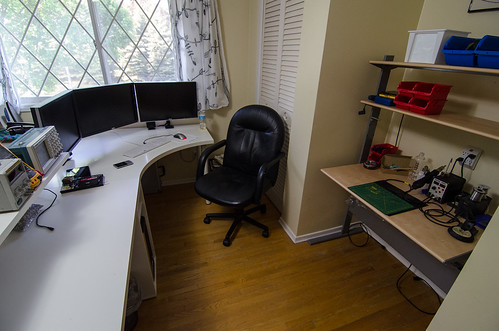Hello folks,
there's lots of places that talk about the workspace required for electronics and soldering etc.... but I was wondering if any of you had any thoughts about your idea setup for software development on embedded devices.
In my case, firmware is developed at some point after the hardware is complete but still requires basic debugging tools such as:
Power Supply (Bench? Wall Wart?)
Basic logic debugging - evaluate I2C writes from your microcontroller etc.
Basic Oscilloscope
Multi-monitor setup
Plenty of USB connectors on the desktop (at least one of them isolated, just in case I zap something).
Would any of you be prepared to share what your space looks like, or maybe better worded, the space you dedicate to that effort.
I'm hoping to move into a small workspace nearby in the next few months, where I'll have a corner for soldering etc, a corner for embedded software etc and a corner for manufacturing (pick and place, test rig etc). Ideas on how to partition it are welcome.
Thanks again folks,
/Rochey
there's lots of places that talk about the workspace required for electronics and soldering etc.... but I was wondering if any of you had any thoughts about your idea setup for software development on embedded devices.
In my case, firmware is developed at some point after the hardware is complete but still requires basic debugging tools such as:
Power Supply (Bench? Wall Wart?)
Basic logic debugging - evaluate I2C writes from your microcontroller etc.
Basic Oscilloscope
Multi-monitor setup
Plenty of USB connectors on the desktop (at least one of them isolated, just in case I zap something).
Would any of you be prepared to share what your space looks like, or maybe better worded, the space you dedicate to that effort.
I'm hoping to move into a small workspace nearby in the next few months, where I'll have a corner for soldering etc, a corner for embedded software etc and a corner for manufacturing (pick and place, test rig etc). Ideas on how to partition it are welcome.
Thanks again folks,
/Rochey




